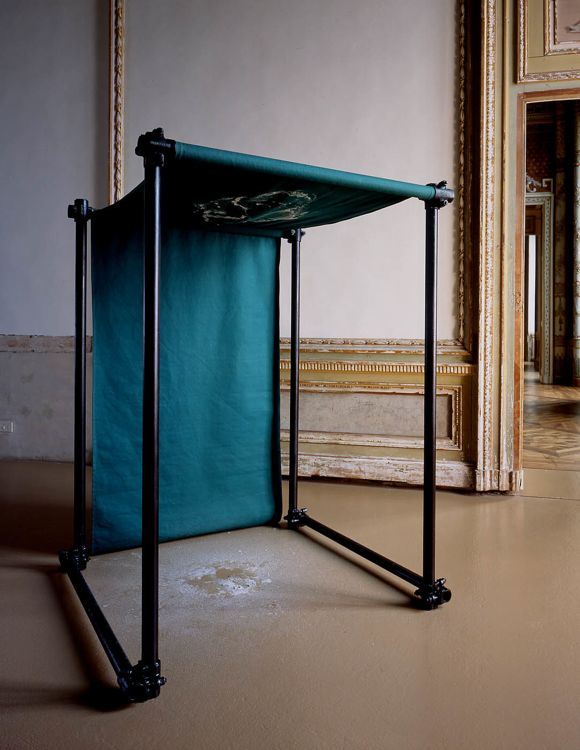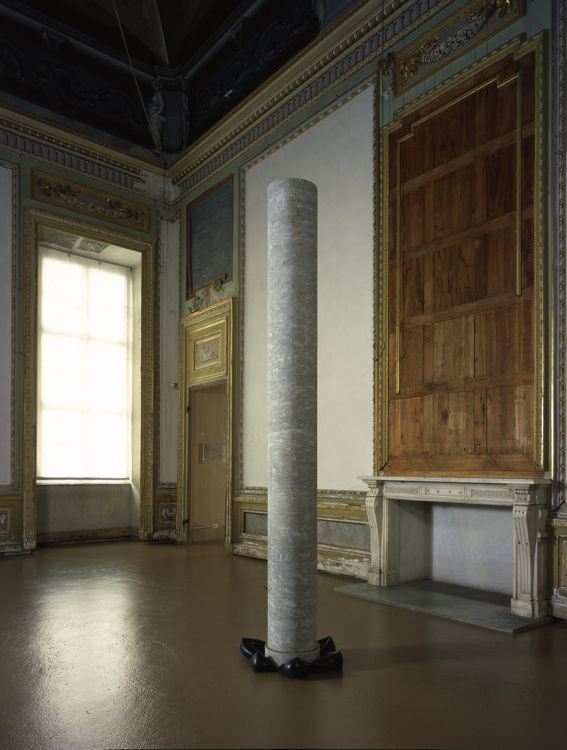Gilberto Zorio
Gilberto Zorio’s works are unending fields of physical and mental energy. One of the leading figures of the Arte Povera group, since 1966 Zorio has directed his investigations toward the processes issues that make each work continually mutable. Setting up chemical or physical reactions, the artist enters his works into a life cycle in which he is present as a spectator. Time is often an important component, in that only the natural passage of hours and days makes fully tangible the transformations to which the works are subjected.
In Tenda (Tent), 1967, the evaporation of seawater and the resulting traces in the form of salt crystals delineate the dynamic of a natural landscape. The salt lake that forms at the viewer’s eye level corresponds to the anthropocentric dimension that Zorio celebrates in his works. Even the installation’s metal tubes on which a cloth rests are conceived by the artist as within a human dimension, and he compares their function to that of the veins and skeleton in a body.
Zorio renews the language of sculpture, freeing it from the fixity and heaviness with which it has traditionally been associated. In Colonna (Column), 1967, a tube of heavy asbestos cement rests on an inner-tire tube, almost as if it were an overturned column. The tube thus remains in precarious equilibrium, and its weight causes the inner tube to harden and the rubber to lose its flexibility. The juxtaposition of the two materials erodes the apparent nature of each, suggesting the image of a rising architecture.
The idea of ascent is also present in Macchia III (Stain III), 1968. Zorio has stated: “I have always been interested in an attempt to raise up sculpture, to suspend it and place it in the air, in order to occupy the entire space, including the aerial horizon.” The work is created by scattering liquid rubber on the ground, in concentric circles. Subsequently the rubber is suspended in the space by cords whose tension is never definitive. The elevation of the sculpture corresponds to the artist’s attempt to make tangible the way the work belongs to the space of the imagination, continually renewing the wonder of an unexpected encounter.
The narrative dimension is often present in Zorio’s works, in the form of a fantastical story that traverses time and space. Thus elements such as crucibles, javelins, goatskins, and especially canoes appear as elements in his work, used as instruments of a possible voyage. Barca nuragica (Nuraghic Boat), 2000, is a section of a canoe made from interwoven rushes, presented as a vector that has traveled through history and different civilizations. Dynamically triangular, the work effects movements that seem like the beginnings of a new journey. Hoisted up in the space, it is also freed by the usual silence of sculpture and restored to life as a result of the whistling emitted by the compressed air that causes its movement.
[MB]



